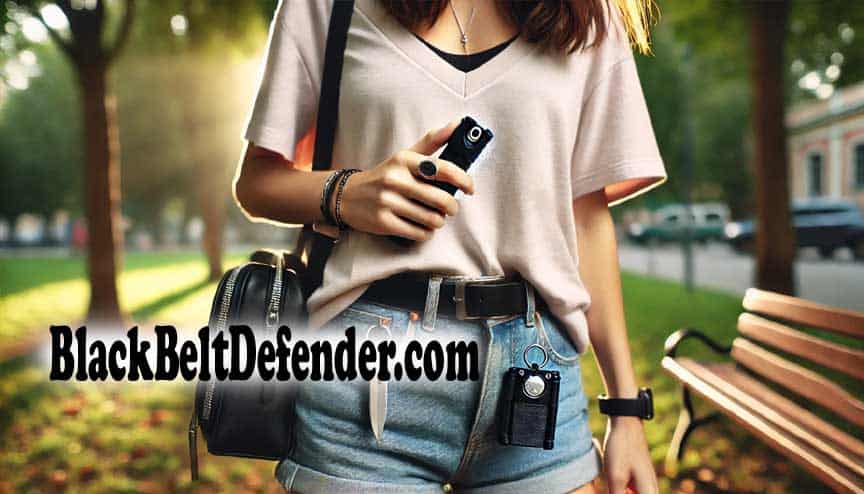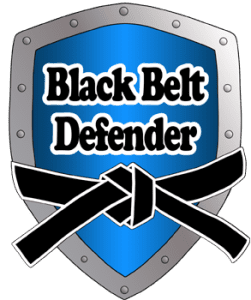
free shipping on orders over $49
We're having a 15% off sale on all our products. Enter your email below to be notified about future sales.




When you’re starting with self-defense, compact and easy-to-use tools are your best bets. Keychain options like pepper spray, personal alarms, and Kubotans offer discreet protection and quick access. Pepper spray is effective, but remember to check its strength, legal restrictions, and practice its use to guarantee precision. Stun guns are also great; they deliver high-voltage shocks, providing non-lethal defense in close-quarter situations. Make sure they’re legal in your area and come with safety mechanisms. Additionally, personal alarms can deter threats immediately and are simple to operate. Exploring these options will certainly enhance your ability to protect yourself.
When choosing your first self-defense tool, consider keychain options for easy carrying and quick access. Self-defense keychains are compact, discreet, and can easily integrate into your daily routine without drawing unnecessary attention. They come in various forms including pepper spray and personal alarms, each designed to offer quick defensive reactions against potential attacks.
Pepper spray attached to keychains provide a direct and potent defense mechanism. You can swiftly pull out the spray and incapacitate an attacker from a safe distance, giving you enough time to escape or seek help. The convenience of having it on a keychain means it’s always within reach, attached to something you carry every day like your keys.
Personal alarms, another keychain accessory, serve as an excellent deterrent. These devices emit a loud sound when activated, drawing immediate attention to your situation. This noise can confuse or scare off an attacker while alerting nearby people to your distress. Personal alarms are particularly useful in crowded areas where the sound can quickly attract attention.
Both options are affordable and effective, making them ideal choices for beginners in self-defense. You’re not just carrying a tool; you’re carrying confidence right on your keychain.
When selecting your pepper spray, you’ll want to take into account size and strength to guarantee it meets your personal safety needs.
It’s important to learn the proper usage and safety tips to maximize effectiveness while minimizing risks.
Additionally, you must be mindful of the legal considerations in your area to avoid potential legal issues.
Selecting the right pepper spray involves understanding its range, size, and potency to guarantee it meets your self-defense needs. Pepper spray is a key tool in non-lethal self-defense, offering a method to deter a potential attacker without causing permanent harm. Due to its compact nature, it’s easy to carry, whether on a keychain or in a pocket, making sure you’re always prepared.
| Feature | Benefit |
|---|---|
| Compact Size | Easily fits in handbags or pockets |
| Non-lethal | Safely incapacitates temporarily |
| Quick Access | Ideal for emergencies |
| Various Sizes | Choose based on personal comfort |
| Effective Range | Ensures safety from a distance |
To use pepper spray effectively, you’ll need to master the correct deployment technique and be mindful of essential safety tips. As one of the most accessible self-defense weapons, pepper spray is a non-lethal weapon that enhances your personal safety by providing a means to disable an attacker temporarily.
Here are some key tips to remember:
Before you carry pepper spray for self-defense, it’s vital to understand the legal restrictions and guidelines in your area. Pepper spray is widely recognized as a non-lethal self-defense tool, but it’s not without its regulations. Most states in the U.S. allow you to use it for self-defense, but you’ll find that some impose limits on the size and concentration of the canisters you can carry.
Always check your local laws to make sure you’re not only compliant but also effectively protected. Legal considerations are important; they ensure that while you’re equipped to defend yourself, you’re also within the bounds of the law. Staying informed helps you navigate the use of pepper spray responsibly.
Stun guns provide an effective and non-lethal option for personal defense, delivering high-voltage shocks that can immobilize an attacker quickly. As a beginner, you might be considering various self-defense tools, and stun guns are a top choice due to their straightforward operation and reliable performance. When you’re in a close-quarters situation where your safety is compromised, having a stun gun can give you the upper hand without the need for vital force.
Here’s why a stun gun might be the right self-defense tool for you:
Understanding the benefits of personal alarms and how to choose the most effective ones can greatly enhance your safety.
As a beginner, you’ll find these devices aren’t only easy to use but also highly effective in deterring potential threats.
Let’s explore why incorporating a personal alarm into your self-defense toolkit is a smart choice.
Personal alarms provide an immediate and effective way to deter attackers and alert others in the event of an emergency. They’re essential for your security, especially if you find yourself in vulnerable situations. Here’s why you should consider including personal alarms in your safety toolkit:
Choosing the appropriate personal alarm can greatly enhance your safety and confidence in threatening situations. Personal alarms, a non-violent self-defense weapon, emit a loud sound that not only scares off potential attackers but also attracts the attention of those nearby.
They’re compact and lightweight, making them easy to carry and quick to access when you need them most. By incorporating a personal alarm into your daily routine, you’re taking a proactive step towards ensuring your peace of mind. These devices provide a practical means of self-defense for beginners, empowering you to feel secure without resorting to physical confrontations.
To effectively use a tactical pen in self-defense, it’s crucial to know how to handle it properly. As one of the best self-defense tools for beginners, a tactical pen offers the dual benefits of everyday usability and emergency readiness. You might be wondering how to integrate a tactical pen into your self-defense strategy. Here’s what you need to focus on:
Mastering the use of a kubotan can greatly enhance your self-defense capabilities. As a beginner, you’ll find this tool not just easy to handle but also highly effective. Kubotans are an excellent self-defense device because of their simple, yet powerful functionality. They’re small, making them a perfect everyday carry item that you can attach to your keychain and have at your disposal whenever needed.
With the right technique, you can use a kubotan to target sensitive areas on an attacker, leveraging your force effectively to incapacitate them and escape harm. Here’s a quick guide to help you understand the basics:
| Feature | Benefit | Use Case |
|---|---|---|
| Compact Size | Easy to carry and conceal | Attached to keychain |
| Simple Design | Minimal training required | Quick defensive reactions |
| Metal Material | Durable and effective | Pressure point application |
| Versatile | Suitable for various scenarios | Self-defense situations |
Keychain defense tools provide you with discreet and effective options for personal safety that easily integrate into your daily life. These compact weapons aren’t only easy to carry but also quick to access during emergencies, making them an excellent choice for beginners looking for self-defense methods.
Here are five keychain defense options to contemplate:
Each of these tools enhances your ability to defend yourself by being both accessible and effective. With keychain defense options, you’re carrying more than just keys—you’re carrying peace of mind. Always contemplate you’re comfortable using these tools and practice regularly to be prepared in any situation.
While exploring various self-defense tools, it’s important to understand the legal considerations surrounding the use of Tasers. As you investigate selecting the right self-defense products, be mindful that Tasers are regulated differently across various regions. These variations in local laws can greatly impact your ability to own and use a Taser.
| State Condition | Description |
|---|---|
| Restricted States | Requires permits/licenses; limited to law enforcement in some areas |
| Permit/License States | Must obtain legal documentation to possess/use |
| Legal Repercussion | Misuse can lead to criminal charges |
| Purchase Restrictions | Certain states limit who can buy a Taser |
You’ll find that in some states, Tasers are considered restricted weapons, primarily available only to law enforcement personnel. This restriction is due to their potential for harm, necessitating careful consideration and responsibility from the user. If you’re thinking about including a Taser in your self-defense arsenal, it’s crucial to check if you need a permit or license. Remember, misusing a Taser not only poses ethical issues but also leads to severe legal repercussions. Always make sure you’re fully informed and compliant with your local laws to avoid any complications.
Keeping your self-defense tools in top condition guarantees they’re ready when you need them most. As part of your home security strategy, it’s important to maintain these tools diligently. This ensures they’ll function effectively, providing you with confidence in your ability to protect yourself. Regular maintenance isn’t just about functionality; it also extends the life of your self-defense tools, making it a cost-effective practice.
Here’s how you can keep your self-defense tools in excellent condition:
If you’re unsure about how to properly maintain any tool, don’t hesitate to contact customer service for guidance. They’re there to help you maximize the effectiveness of your self-defense tools.
The most effective self-defense tool varies, but pepper spray tops the list. It’s legal, easy to use, and keeps attackers at bay. Consider personal alarms and defense classes to enhance your safety.
For self-defense, consider weapons that balance legal implications, training requirements, and accessibility. Pepper spray and tactical pens are great as they’re easy to carry and require minimal training while being legally permissible.
The #1 rule of self-defense is situational awareness. You’ll need awareness training, escape planning, and understanding of legal considerations to effectively protect yourself. Always be alert and aware of your surroundings.
You’ll find personal alarms, defensive sprays, and tactical flashlights among the easiest self-defense methods. They’re simple to use, quick to deploy, and highly effective at providing safety in threatening situations.
As always, be safe and be prepared.
See Also:
Black Belt Defender
1867 Caravan Trail #105
Jacksonville, FL 32216-2006
Call us toll-free: (800) 859-5566
Mon-Fri: 9:00 am – 5:00 pm EST
NH based, FL Warehouse
Online Orders: 24/7/365

